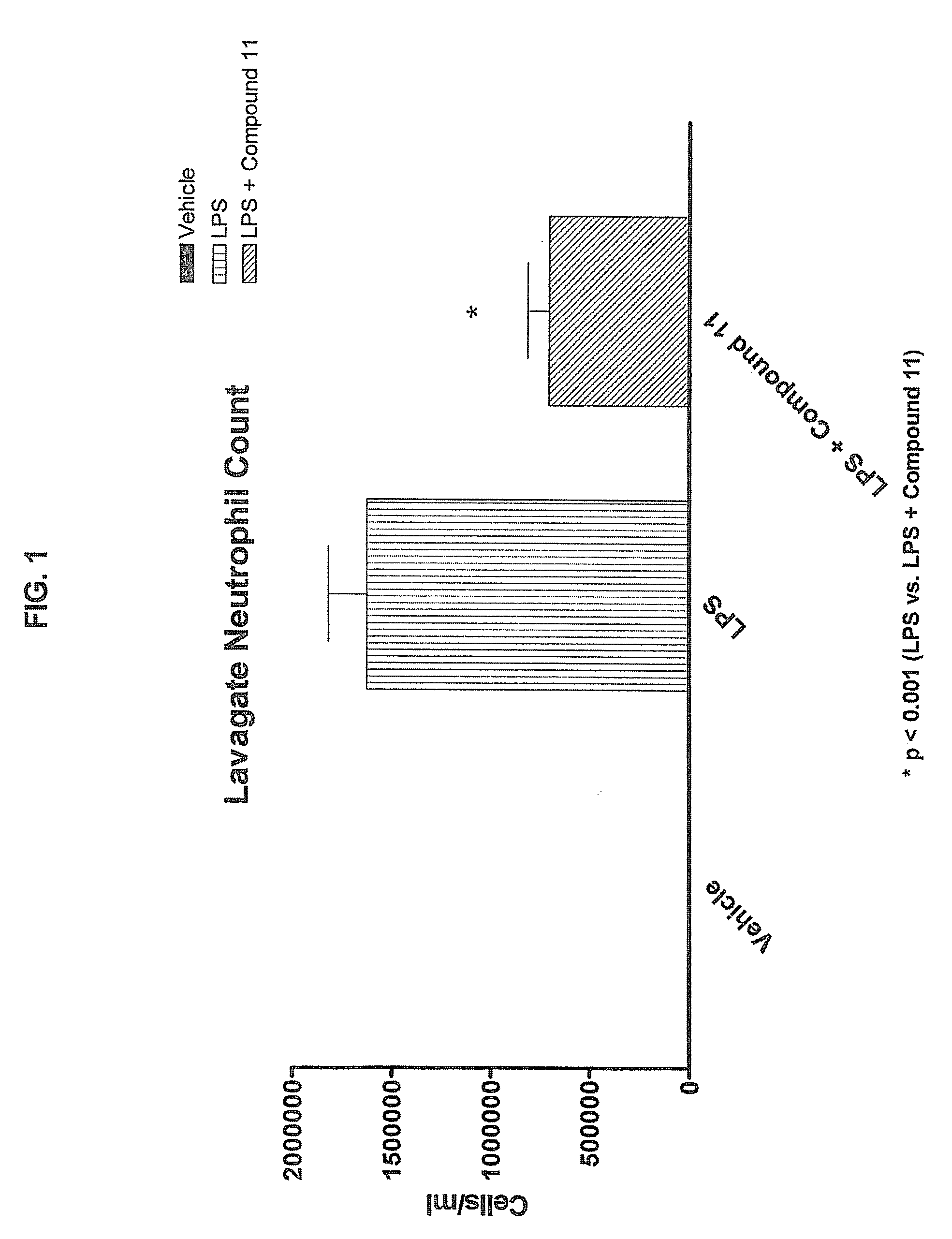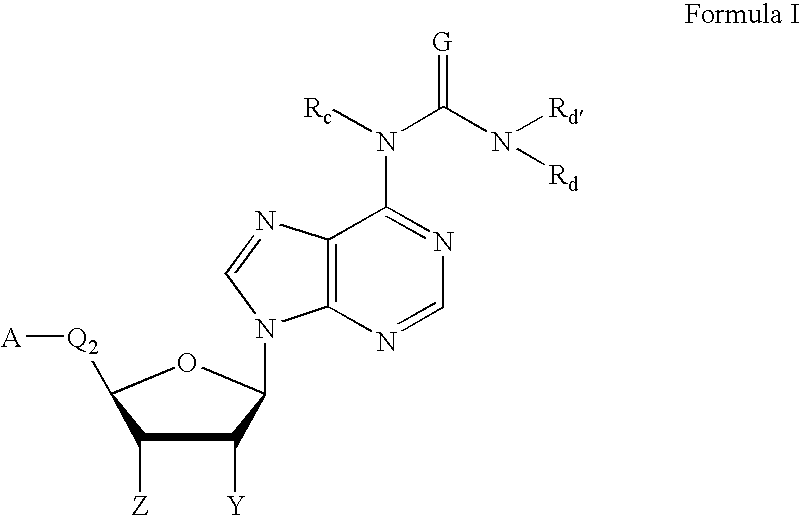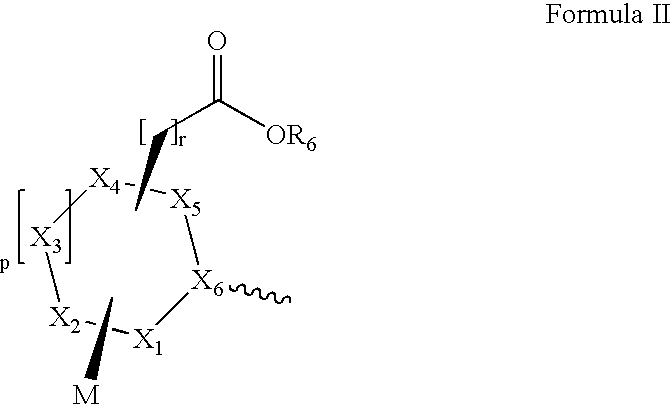Method of treating inflammation
a technology of inflammatory cells and cytokines, applied in the field of modulating inflammatory cell migration, can solve the problems of neutrophils themselves promoting tissue damage, causing significant tissue damage (or cell death), and producing tissue damage, so as to inhibit the chemotaxis of white blood cells and inhibit inflammation
- Summary
- Abstract
- Description
- Claims
- Application Information
AI Technical Summary
Benefits of technology
Problems solved by technology
Method used
Image
Examples
example 1
Preparation of cis-[6-(6-amino-purin-9-yl)-2-styryl-tetrahydro-furo[3,4-d][1,3]dioxol-4-yl]-methanol (2a) and trans-[6-(6-amino-purin-9-yl)-2-styryl-tetrahydro-furo[3,4-d][1,3]dioxol-4-yl]-methanol (Compound 2b)
[0147]A 3 L flask equipped with a mechanical stirrer, addition funnel, internal temperature monitor and nitrogen inlet was flushed with nitrogen and charged with 90 g of (−)-adenosine (1) and 0.339 L of trans-cinnamaldehyde. After cooling (acetone / wet ice bath) to −50 C., 0.403 L of trifluoroacetic acid was added keeping the temperature between −50 C. and +50 C. The reaction was stirred at 00 C. until 80% conversion is achieved (approximately 2 hours, as measured by HPLC). The reaction was then diluted with 1.1 L of iso-propyl acetate maintaining a reaction temperature of 0 C. The reaction was then quenched with 0.810 L of 5 N sodium hydroxide maintaining a reaction temperature of 200 C. to 250 C. During this quench, the product crystallized and two layers were formed. After ...
example 2
Preparation of trans-[6-(6-amino-purin-9-yl)-2-styryl-tetrahydro-furo[3,4-d][1,3]dioxol-4-yl]-methanol (Compound 3)
[0148]A 1 L flask equipped with a mechanical stirrer, addition funnel, internal temperature monitor and nitrogen inlet was flushed with nitrogen and charged with 50 g of a 1.5:1 mixture of trans:cis-[6-(6-amino-purin-9-yl)-2-styryl-tetrahydro-furo[3,4-d][1,3]dioxol-4-yl]-methanol (2a / 2b), 18.6 g of p-toluene sulfonic acid, 0.2 L of tetrahydrofuran and 0.050 L of water. The reaction was warmed to 500 C. and stirred until the HPLC area % ratio of trans-[6-(6-amino-purin-9-yl)-2-styryl-tetrahydro-furo[3,4-d][1,3]dioxol-4-yl]-methanol to cis-[6-(6-amino-purin-9-yl)-2-styryl-tetrahydro-furo[3,4-d][1,3]dioxol-4-yl]-methanol was >99:1.0. The reaction was then quenched with 0.150 L of 2 sodium hydroxide and stirred for 10 minutes. Agitation was stopped and the phases allowed to separate. The lower aqueous phase was decanted and agitation was continued. The reaction was then dil...
example 3
Preparation of trans-9-[6-(tert-butyl-dimethyl-silanyloxymethyl)-2-styryl-tetrahydro-furo[3,4-d][1,3]dioxol-4-yl]-9H-purin-6-ylamine (Compound 4)
[0149]A 3 L flask equipped with a mechanical stirrer, addition funnel, internal temperature monitor, nitrogen inlet and vacuum line was flushed with nitrogen and charged with 100 g of trans-[6-(6-amino-purin-9-yl)-2-styryl-tetrahydro-furo[3,4-d][1,3]dioxol-4-yl]-methanol (3) and 2 L of iso-propyl acetate. The reaction was warmed to reflux and 0.600 L of distillate was collected. The reaction was then charged with 1.0 L of N,N-dimethyl formamide and distillate was collected until a pot temperature of 1000 C was reached at a pressure of 200 torr. The reaction was then cooled to 200 C. The reaction was then charged with 0.0223 kg of imidazole and 0.0474 kg of tert-butyl dimethylsilyl chloride. After stirring for two hours the reaction was tested for completeness by HPLC. The reaction was then quenched with 1.4 L of a 2.5:1 mixture of water / 2-p...
PUM
| Property | Measurement | Unit |
|---|---|---|
| Compatibility | aaaaa | aaaaa |
Abstract
Description
Claims
Application Information
 Login to View More
Login to View More - R&D
- Intellectual Property
- Life Sciences
- Materials
- Tech Scout
- Unparalleled Data Quality
- Higher Quality Content
- 60% Fewer Hallucinations
Browse by: Latest US Patents, China's latest patents, Technical Efficacy Thesaurus, Application Domain, Technology Topic, Popular Technical Reports.
© 2025 PatSnap. All rights reserved.Legal|Privacy policy|Modern Slavery Act Transparency Statement|Sitemap|About US| Contact US: help@patsnap.com



